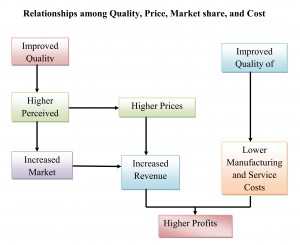Relationships among Quality, Price, Market share, and Cost
Quality and Price
Many believe that higher quality can only be produced at a higher cost; therefore, they assume that higher prices imply higher quality. This is not always the case. Research studies have found that when other factors such as brand name, store image, product features, or country of origin influence consumer perception, quality assessment is not as heavily influenced by price. Also, if managers observe that consumer perceptions of quality and purchasing decisions are positively related to price, they may command higher prices without actually increasing quality. As a result, price often bears a positive relationship to perceived quality rather than actual quality. Higher prices may actually reflect inefficiencies in production, high fixed costs, and poor quality.
When a purchase decision involves great uncertainty,consumers tend to rely on a high price as a predicator of good quality.Reliance on price as an indicator of quality seems to occur for all products,but reveals itself more strongly for some items than for others.Among the products that benefit from this phenomenon are coffee,aspirin,salt,shampoo,clothing,furniture and many services.In the absence of other information,people typically assume that prices are higher because the products contain better materials,because they are made more carefully,or in the case of professional services,because the provider has more expertise.In other words,consumers assume that”You get what you pay for”.
Research has found that products that are perceived to be of high quality tend to benefit more from price promotions than products perceived to be lower quality.However when perceived high and lower quality products are offered in settings where consumers have difficulty making comparisons,then price promotions have an equal effect on sales.
Quality and Market Share
If a product or service meets or exceeds customer expectations, we would expect quality and market share to be positively related. We saw this in the 1970s as higher quality Japanese products made significant penetration into Western markets. This also has been verified by many research studies. For example, one study found that businesses that improved quality during the 1970s increased their market share five to six times faster than those whose quality declined, and three times as fast as those whose quality remained unchanged. The PIMS studies found that businesses offering premium quality products and services usually have large market shares and were early entrants into their markets, and that a strategy of quality improvement usually leads to increased market share, but at a cost in terms of reduced short-run profitability.
Quality and Cost
From the viewpoint of quality of design, improved quality generally results in higher costs. Improved quality of design requires more costly materials, more highly skilled labour, and more expensive equipment. As argued earlier, however, improved quality of design can lead to increased revenues through higher prices and market share that can far outweigh the additional costs. On the other hand, improved quality of conformance usually results in decreased costs through savings in rework, scrap, and warranty expenses.
These relationships among quality, price, market share, and cost are summarized in the figure given below. The value of a product in the marketplace is determined by the quality of design. Improved design will enhance a firm’s reputation and the consumer’s perception of quality, resulting in the ability to command higher prices and achieve increased market share, leading to increased revenues. Improved quality of conformance leads to lower manufacturing and service costs. The net effect of this two-pronged strategy for quality improvement is increased profits.


